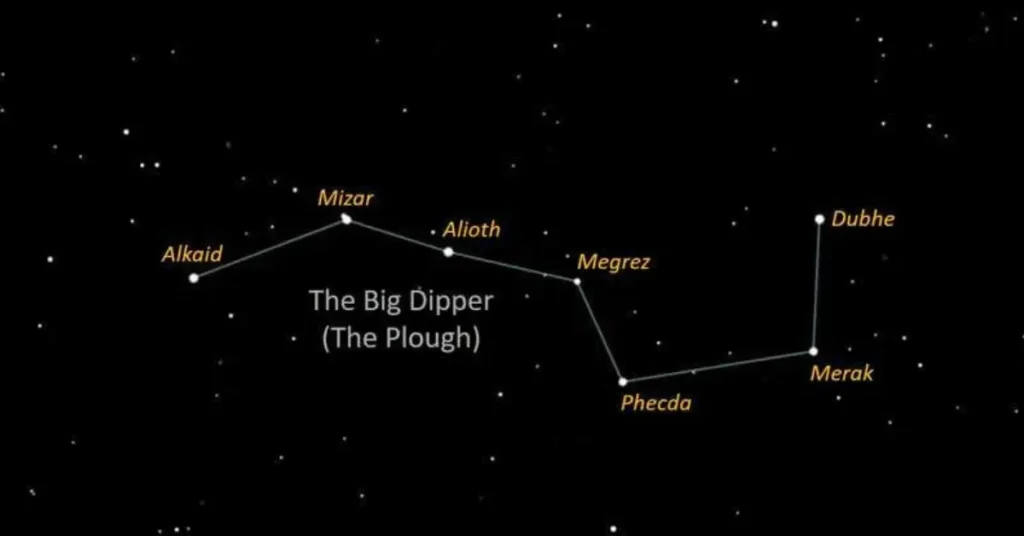The Big Dipper, a celestial landmark etched in the minds of stargazers young and old, has captivated humanity for millennia. Its recognizable ladle-like shape, formed by seven bright stars, has served as a guide for travelers, navigators, and storytellers across cultures and continents. But how many stars truly make up this iconic asterism?
While the answer seems simple – seven, right? – the reality is slightly more nuanced. The Big Dipper isn’t actually a constellation in itself, but rather an asterism, a recognizable pattern within a larger constellation. This means it’s not an officially defined grouping of stars by astronomers, but rather a shape readily identified by the human eye.
Number of Stars In Big Dipper: The Seven Shining Stars
The seven stars that form the Big Dipper belong to the constellation Ursa Major, the Great Bear. Each star has its own name and unique characteristics:
- Dubhe (α Ursae Majoris): The brightest star in the Dipper, marking the end of the “handle.”
- Merak (β Ursae Majoris): Partnering with Dubhe, it forms a crucial pointer towards Polaris, the North Star.
- Phecda (γ Ursae Majoris): The faintest of the seven, located at the “bend” of the handle.
- Megrez (δ Ursae Majoris): The lone third-magnitude star in the group, positioned at the base of the “bowl.”
- Alioth (ε Ursae Majoris): Marking the “tip” of the bowl, it’s known for its double star system.
- Mizar (ζ Ursae Majoris): Another double star, forming the middle star of the bowl.
- Alkaid (η Ursae Majoris): The last star in the handle, completing the iconic shape.

Also read: Who Flies in Air Force 2?
Beyond the Seven:
While these seven stars form the most recognizable part of the Big Dipper, they are not the only members of Ursa Major. The constellation boasts over 80 named stars, many of which are fainter and less visible to the naked eye.
This highlights the distinction between an asterism and a constellation – the former focuses on a specific, easily identifiable pattern, while the latter encompasses a larger area with a richer history and scientific significance.
Unveiling the Mystery:
So, back to the initial question: how many stars are there in the Big Dipper? The answer depends on your perspective. If you consider only the seven bright stars that form the recognizable shape, then it’s seven. However, if you include the entire constellation of Ursa Major, the number jumps to over 80.
Understanding this distinction sheds light on the beauty and complexity of the night sky. The Big Dipper, as a prominent asterism, serves as an accessible entry point for stargazers to explore the vastness of the universe. But beneath its familiar form lies a whole constellation, brimming with hidden stars and untold stories waiting to be discovered.
So, the next time you gaze upon the Big Dipper, remember that it’s just a glimpse into a much grander celestial tapestry. Its seven shining stars may be the first to capture your eye, but they are just the beginning of an awe-inspiring journey through the wonders of the cosmos.
Is there a Difference Between Asterism and a Constellation?
Both asterisms and constellations are patterns of stars in the night sky, but they have key differences:
1. Official Recognition:
- Constellation: Officially recognized by the International Astronomical Union (IAU), with defined boundaries and scientific significance.
- Asterism: Not officially recognized by the IAU, but a recognizable pattern within a constellation or spanning multiple constellations.
2. Size and Scope:
- Constellation: Generally larger, encompassing many stars and faint objects like nebulae or star clusters.
- Asterism: Typically smaller, focusing on a recognizable and easily identifiable pattern of bright stars.
3. Purpose:
- Constellation: Used for celestial navigation, identifying objects, and understanding stellar structures.
- Asterism: Used for easier stargazing, finding directions, and passing down cultural stories.
4. Examples:
- Constellation: Ursa Major (Great Bear), Orion, Lyra
- Asterism: Big Dipper (within Ursa Major), Summer Triangle (spanning Aquila, Lyra, Cygnus)
Think of it this way:
- Constellations: Organized libraries of stars, with official maps and detailed information.
- Asterisms: Familiar landmarks within those libraries, quick guides for navigation and storytelling.
The Big Dipper is a famous asterism within the constellation Ursa Major. So, next time you see it, remember you’re looking at both a recognizable pattern and part of a larger celestial map!
FAQs
1. How many stars are in the Big Dipper?
7, but it’s an asterism, not a constellation
2. What are the names of the stars in the Big Dipper?
Dubhe, Merak, Phecda, Megrez, Alioth, Mizar, Alkaid
3. How do I find the North Star using the Big Dipper?
Follow the line through Merak and Dubhe 5 times the distance
4. Is the Big Dipper visible all year round?
Yes, from most parts of the Northern Hemisphere
5. What are some interesting facts about the Big Dipper?
It’s part of a larger constellation, home to double stars, and has inspired stories across cultures
Content Contributor: Rehana Sengupta









